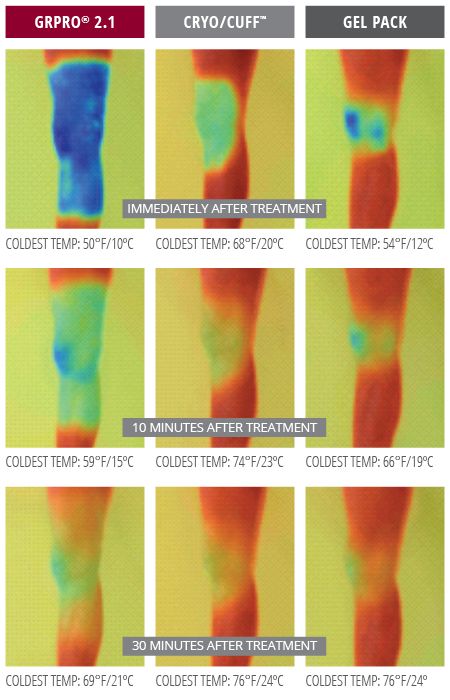Información clínica
Game Ready cold works faster, penetrates deeper, and lasts longer
Game Ready's active compression squeezes greater benefits out of cold therapy alone. Using patented spacesuit technology, Game Ready's circumferential wraps envelope the injury or surgery site. Pneumativ compression works to conform the wrap tot he contours oft he body, assuring better surface contact and thus more effective cooling. Head to head infrared thermal imagery shows that Game Ready provides faster, deeper, and longer-lasting cold than other cryotherapy products.
Multimodality system with up to five performance characteristics
-
Compression bandage (up to 75 mmHg)
-
Lymphatic drainage (intermittent)
-
Support and stabilization bandage (semi-rigid, plastic stabilization, pneumatic)
-
Cold compress / cuff (effective area over 300 cm2, self-contained and sealed cryosystem)
-
Contrast bath therapy or rapid contrast therapy (dry, from 3°-45° under 1 minute)
It is recommended to clarify in advance any compensation by mentioning the above-mentioned characteristics directly with your personal health or accident insurance.
* Game Ready thermal imagery featuring treatment with GRPro 2.1 system. Side views shown. First skin temperature measurement immediately treatment after 30 minutes of treatment, subsequent images at 10 and 30 minutes post-treatment. All devices applied per manufacturer’s instructions and all measurements taken from uniform distance. All devices applied on different days allowing full recovery for test subject.

Clinical benefits - scientifically proven
Game ready's active compression with active cold therapy
Reduces patient narcotic consumption and allows earlier discontinuation of narcotic pain medications.
Improves key, measurable physical therapy milestones.
Increases patient satisfaction with recovery process.
Reduces likelihood for blood transfusion.
Shortens patient hospital admission time.
Provides less wound discharge.
Reduces risk of infection.
Improves surface contact for faster, deeper, longer-lasting cooling.
Decreases pain, muscle spasms, edema, and swelling.
Cold (general)
Reduces metabolic activity and cellular demand for oxygen, reducing secondary tissue damage.
Compression (general)
Aids in the prevention of edema formation and removal of swelling.
Active cold
Draws heat away from the injury site for more efficient temperature reduction.
Active compression
Mimics natural muscle contractions, "pumping" edema out of the injured area.
Optimizes lymphatic drainage.
Increases blood flow and oxygen delivery.
Stimulates tissue repair, encouraging acceleration of the healing process.
